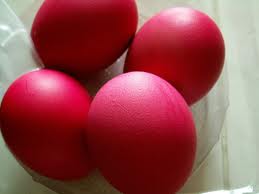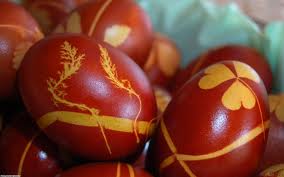EASTER CUSTOMS
by our 5th graders
Our school participates this year in an eTwinning project that involves learners in exchanging customs and traditional dances with other European schools. For the upcoming exchange, our 5th grade learners have prepared presentations of the Greek Easter customs and of other information related to Easter that they looked up on the internet!
Easter in Greece
by Valentina Velikova
During Easter week Greek people do not eat meat, fish or milk. They go to the church every afternoon.
On Easter Thursday Greek housewives dye red eggs and bake ‘’tsoureki’’, a traditional sweet bread. At night, women decorate Christ’s Epitaph with beautiful flowers.

On Easter Friday night the Epitaph goes around the village or town, followed by people who hold candles. This is like a funeral, so everybody is sad.
On Easter Saturday we go to church at night and at 12 at midnight we celebrate Christ’s resurrection. Then, we go home and eat “magiritsa’’, a soup with animal liver, lungs and intestines. It sounds disgusting, but it is really tasty!

On Easter Sunday we roast a lamb and we hit each other’s red eggs. We listen to music and we dance. We usually celebrate Easter Sunday with our family.
Easter Sunday in Greece
by Kosmas Gourgiotis
At Easter I go to the church. After that, I help my dad to roast the lamb. Then, we light a fire to roast it. We eat the lamb, but we also eat ‘kokoretsi’ and ‘kontosoufli’ with my parents. We drink wine and hit each other’s egg. Some people shoot with a gun in the air. I drink coca cola. At the end of the lunch we dance.

Easter in Skiathos
by John Kalantzis
Skiathos is one of the few areas in Greece that follows the Easter ritual of Agion Oros (a Greek area full of Orthodox monasteries with monks – women are not allowed in).
About 4:00 in the morning of the Easter Saturday, the Epitaphs from the two churches are carried out and they pass around the town.

The Epitaphs go along the narrow streets and paths of the island. People in all the houses have turned on the lights. The frankincense smells great! The two Epitaphs come back and meet at the church of the ‘Three Hierarchs’ and all the people come together and continue passing around as a group. They all go back to the churches at about 5:30 in the morning.

The people in the morning get ready for the Easter Saturday night celebration that is the Christ’s resurrection.
The red eggs
by Helen Kaltsouni
The red eggs of Easter. The eggs are a symbol of life and birth in many cultures. Especially the red eggs have been used in celebrations in China from the 5th century and in Egypt from the 10th century. It is in the 17th century that we find them in Christians and Mohammedans. For the early Christians the red egg is the symbol for Christ’s resurrection. In the Middle Ages people dyed red eggs to give them as presents for Easter.

Easter eggs with red colour. Some believe that people dye red eggs as a memory of the Christ’s blood, which He poured out for us, the people. Red is the colour of pleasure too. For some people, it is a symbol for the pleasure for Christ’s resurrection. The dying of the eggs was done on Easter Thursday, so it also called Red Thursday. In the past, the saucepan where they dyed the eggs had to be new and the number of the eggs had to be certain and they kept the red paint for forty days and they didn’t pour it out of the house. The colours for the eggs were made from different plants, like onions, poppies, violets etc. But the red colour was and is always the most favourite colour for the Easter eggs. Nowadays, most housewives use some kind of powder they buy from the supermarkets, giving thus the eggs a vivid red colour.

Natural decals. In the old times they chose leaves from plants and flowers and they put one of them on each egg. Then, they rolled up an old sock all over the egg, which they made secure with a string and then they dyed the Easter eggs.

The first dyed red egg. In the past, the first egg which they had dyed was for Virgin Mary and they put it at the shrine. Holding the egg, they were forming a cross in the air in front of the children to protect them from the evil eyes.
The resurrection of Jesus
by George Papargiris

Every Easter Saturday morning we go to the church. After the church the housewives make mageiritsa, a traditional Easter soup. The men prepare the lamb for Easter Sunday. In the evening we go again to the church and we celebrate Christ’s resurrection by lighting our candles with the Holy Flame. Then, we go home and form a cross on the upper part of our house door frame for good luck. After that, we enjoy our dinner as the fasting period is over. In the morning we go to the church. After the church we cook the lamb. At noon we eat the lamb and we drink wine. Easter is a very big celebration.
Easter rabbits
by Danae Xiromeriti

The Easter rabbit was actually a bunny. For the Saxons the bunny was the symbol of the goddess Eastre, who was celebrated in spring. This is where the word ‘Easter’ comes from in English. For the Kelts and Scandinavians, the bunny is the symbol of the goddess of motherhood and the spring fertility. The traditional bunny which brings eggs to children is of German origin. In Greece, every child’s godmother buys him or her a chocolate Easter bunny or egg. Do you know what they offer in some other countries?
In Australia they offer chocolate roosters.
In Sweden they offer chocolate foxes.
In France they offer chocolate bells.
In Great Britain they offer chocolate bunnies.
The Sunday before Easter
by Valentina Velikova
On Sunday before Easter we celebrate the entrance of Jesus Christ in Jerusalem. All of the churches are decorated with bay tree leaves and olive tree leaves. People who go to church on that day take tree leaves from the church at home.

In the old days, people used to give bay tree leaves to the newly-married couples for good luck. They also believed that these bay tree leaves would bring fertility to the couple.
People also believed that hitting someone with bay tree leaves had a healing power. They also used to hit their houses, their animals, their fields, their boats, etc for good luck.

















